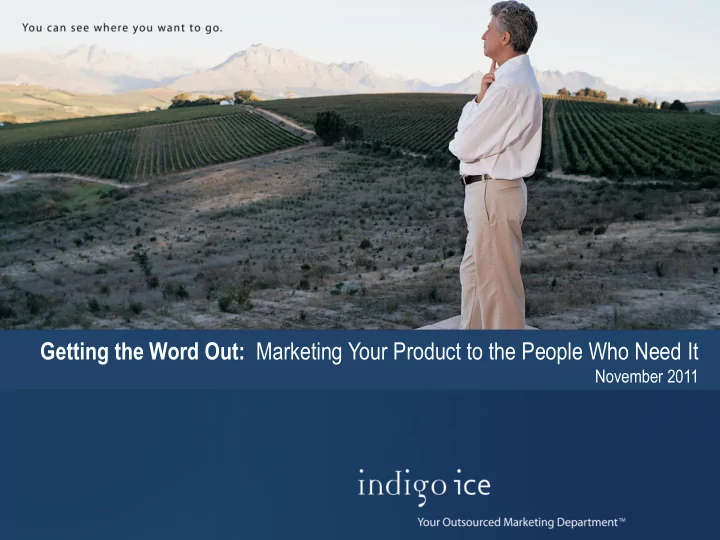

Getting the Word Out: Marketing Your Product to the People Who Need It November 2011
I am what happens when it‟s time to tell people about your products.
Before you start … • Begin your marketing planning and process by understanding – and documenting: – What the market looks like including PEST and SWOT – Your desired sales, market share and profitability numbers – Your marketing budget (remember: marketing is an investment not an expense. How do you want to „look‟ out there?!?) – If you don‟t know what the path looks like, it‟s foolish to start the journey Remember: You get ONE first chance. Make it count.
The Three B‟s • Everything I know about success in marketing comes down to three key Bs. CLEAR PROFESSIONAL THE AUDIENCE
The Three B‟s CLEAR
B … “Clear” • Know the “basics” inside and out. Marketing is a discipline: a combination of science and art. Your primary focus should be the science. – Product – Place – Price – Promotion • Marketing is not an expense, its an investment – people will not buy from you just because you believe in what you‟re selling
B … “Clear” • Product – Define your product including its attributes and reason for being – Have you assessed the market? How big is it? Is there room for another competitor? Contemplate both direct and indirect competition … including perceptions … – Have you tested the product in market? Do you need to? – How is your product different from the competition? – How will you position the product in the market? price? flexibility? durability? insulative properties? – Why should anyone care ?
B … “Clear” • Place – Where – and how – will you sell your product? – What‟s your geographic strategy? Does the product function/react the same in every market? Will it have to be tweaked for foreign markets? – What is your channel strategy? • Direct to builder? • Direct to retail? • Through influencers (architects, etc.)? • Through a wholesaler/distributor? • Bundled with another product? – Run the numbers/feasibility assessment for each
B … “Clear” • Price – Price is based on 3 Cs: customer demand, cost function* and competitor pricing • In the cost function, costs set the floor and customer assessment of unique product features and associated value sets the ceiling – Pricing strategy options: 1. MarkUp (cost plus) 2. Target Return (target rate of ROI) 3. Perceived Value (price based on „what it‟s worth‟) 4. Value Pricing (relative to market) 5. Going Rate Pricing (based largely on competition) – Also contemplate discounts (volume, cash, seasonal)
B … “Clear” • Promotion – What‟s in a name? Be “memorable”, “ speakable ” and “understandable” – Who is the target audience? Who‟s the purchaser … who‟s the influencer … who‟s the economic buyer? – What‟s your image and your message? – How will you move people to action? (rational, emotional, moral) – What tactics will you use? (corporate communications, advertising, promotion, public/media relations, tradeshows/industry events, direct marketing) – What‟s your budget? (typical budgets = 10 – 20% in industrial equipment, 30 – 50% in consumer cosmetics)
The Three B‟s CLEAR PROFESSIONAL
B … “Professional” • Have your „stuff‟ together • Quality and consistency of presentation • You‟re not the first – think of everyone they‟ve already met and find a way to stand out as being more important and more relevant • Assume they‟ll give you 15 minutes • Get OUT of your own head – focus on their interests • Don‟t ever let them feel like they‟d be “taking a chance” on you
B … “Professional” • How people buy: ↓ Awareness ↓ Interest ↓ Evaluation ↓ Trial ↓ Adoption • Five characteristics that affect rate of adoption: 1. Relative advantage 2. Compatibility (of values and experiences) 3. Complexity 4. Divisibility (can be tried on a limited basis) 5. Communicability (observable and desirable to others)
B … “Professional” • Have a clear ask. Have a clear sell. • Don‟t oversell – literally or figuratively.
The Three B‟s CLEAR PROFESSIONAL THE AUDIENCE
B … “The Audience” • Put yourself in the shoes of the audience: what problem or challenge are you solving for them? • Be cynical: assume they don‟t want you • Understand their argument and prove “why you” • Focus on their bottom line – it needs to matter to their customers • Understand how they make decisions and make it easy for them to say „yes‟ • Understand their channels • Don‟t overcomplicate the issues
B … “The Audience” • WHY SHOULD THEY CARE?? Stay focused on the core principles of business and make a compelling case.
Conclusion • Successful marketing and communications isn‟t about a swishy look and feel … it‟s about strategically approaching a sales argument – Channel your passion into a compelling argument – Do your homework – Hire help if you need it
Thank you!
Recommend
More recommend